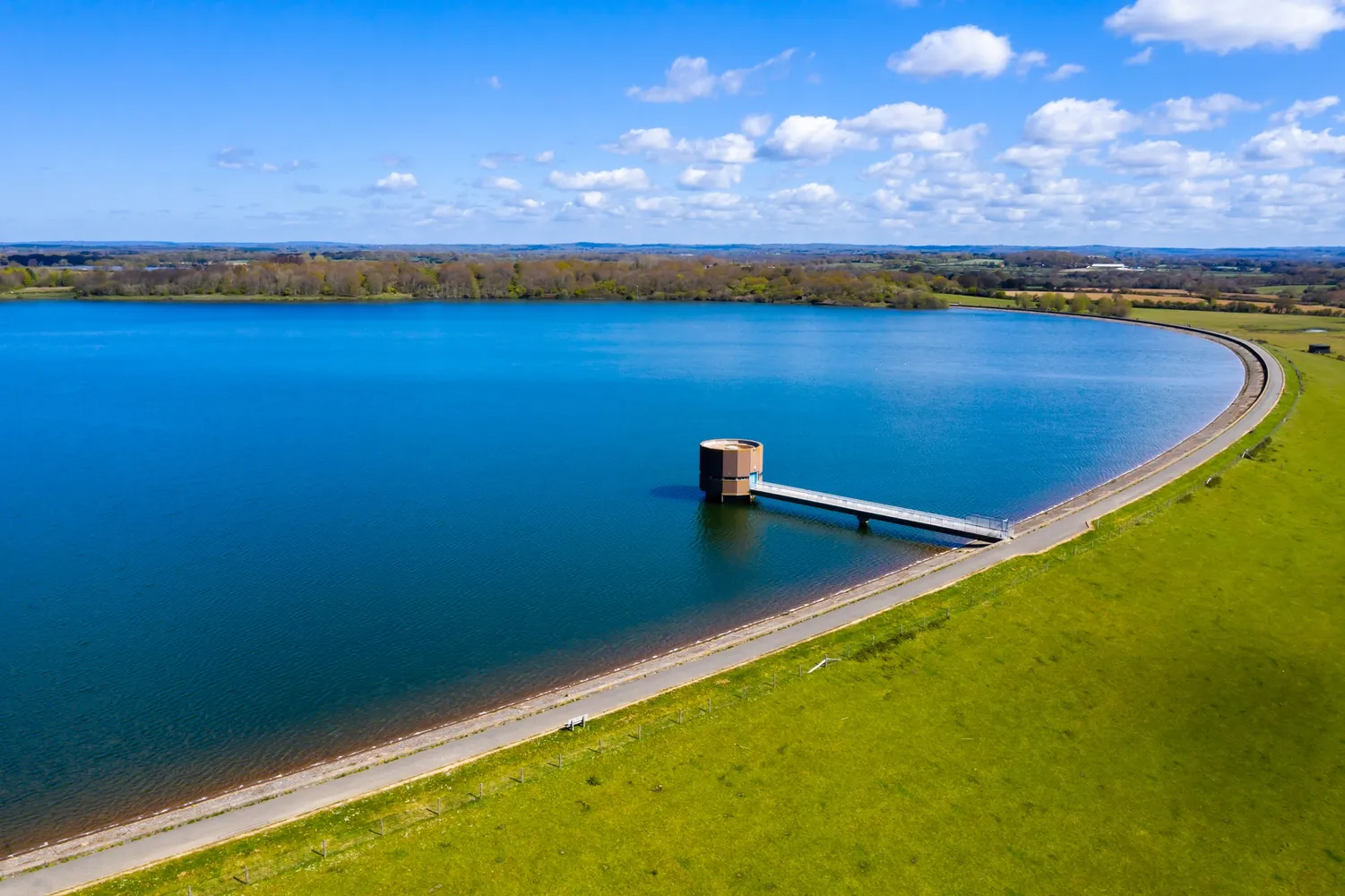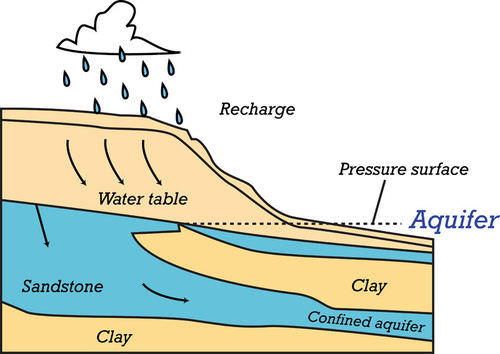A Reservoir and an Aquifer are natural underground water sources, but they have different characteristics and functions. What is the Difference Between an Aquifer and a Reservoir?
Aquifers: An underground layer of H2O-bearing rock
H2O is contained within permeable rock
Supplies H2O to wells/springs
Located under the Earth’s surface
Reservoirs: A man-made or natural lake
Created by constructing a dam across a river/stream
Stores H2O for drinking/irrigation/recreation
Located above ground
What is the Difference Between an Aquifer and a Reservoir
An Aquifer is a geological formation consisting of porous rock or sediment capable of storing and transmitting groundwater. It serves as a natural underground reservoir, supplying water to wells, springs, and streams through the process of groundwater recharge.
In contrast, a Reservoir refers to a body of water, typically created by dams across rivers or valleys, to store water. Reservoirs can be natural, such as lakes formed by geological processes, or artificial, serving human needs like drinking water, irrigation, flood control, and hydroelectric power generation. While both aquifers and reservoirs contribute to water storage and distribution, they differ in their geological formations, water sources, and management purposes. 
The essential difference between aquifers and reservoirs lies in their form and function within Earth’s hydrological makeup. Aquifers are underground reservoirs, secret caches of aquifer groundwater cradled in water-bearing porous rock or sediment. These underground layers, invisible to the eye, serve as natural storage units, replenishing wells and springs.
On the flip side, a reservoir, typically an artificial lake, comes into being when a dam corrals a river’s flow. Unlike the discreet water table lying hidden within aquifers, a reservoir’s presence is quite conspicuous, often a hub for recreation and a source of drinking water. Understanding what is the difference between these two watery worlds unravels the myriad ways we rely on their life-sustaining bounty, from quenching a community’s thirst to irrigating vast stretches of farmland.
Definition and Key Differences of Aquifer Groundwater and Reservoirs
When looking at the difference between an aquifer and a reservoir, you encounter two crucial structures. With an aquifer it essentially acts like a big sponge that is tucked into Earth’s geological layers, a natural subsurface phenomenon where aquifer groundwater is stored, often slicing through porous rock and soil. It’s not rare to hear that aquifers are giant water reservoirs, yet they are distinctly marked by their permeability, allowing water to flow through their matrix.
Exploring Types of Aquifers: Confined Aquifers and Groundwater Aquifers
Confined aquifers and groundwater aquifers are both types of underground water reservoirs, but they have differences in their geological characteristics and water flow dynamics:
- Confined Aquifers:
- Confined aquifers are located beneath impermeable layers of rock or sediment, such as clay or shale, which act as confining layers.
- The impermeable layers restrict the movement of water into or out of the aquifer, creating pressure within the aquifer.
- These aquifers are often under higher pressure compared to unconfined aquifers due to the confinement, which can result in artesian wells where water naturally flows to the surface without the need for pumping.
- The water in confined aquifers is typically older and may have been stored underground for extended periods.
- Unconfined (or Groundwater) Aquifers:
- Groundwater aquifers are not constrained by impermeable layers above them. Water can move freely into or out of the aquifer, allowing it to interact more readily with surface water and recharge from precipitation.
- These aquifers are typically closer to the surface and may be more susceptible to contamination from surface pollutants.
- A Groundwater system in unconfined aquifers is generally under less pressure compared to confined aquifers and may require pumping to extract drinking water for use.
In summary, the main difference between confined and groundwater aquifers lies in their geological setting and the degree to which they are constrained by impermeable layers. Confined aquifers are more restricted and often under higher pressure, while groundwater aquifers are more open and connected to surface water sources.
A Closer Look at Aquifer Groundwater: Essential for Diverse Species
Aquifer groundwater serves as a vital resource for diverse species, sustaining ecosystems and habitats. It provides essential hydration for plants, animals, and microorganisms, contributing to biodiversity and ecological balance. Protection and sustainable management of aquifers are crucial for ensuring the continued survival and well-being of numerous species dependent on groundwater resources.
Diving beneath the surface, a closer look at aquifer groundwater reveals a complex tapestry of life, integral to ecosystems both above and within an aquifer. These hidden oases house diverse species, some of which are uniquely adapted to the aquatic conditions found in these subterranean realms. Aquifer groundwater is essential, serving not only as a lifeblood for terrestrial flora and fauna but also nurturing the aquifer ecosystem.
The constant, cool flow from springs sustains communities that would otherwise be parched expanses. Moreover, the purity of spring waters emerging from aquifers often supports specially adapted aquatic species, which would struggle in less pristine conditions. With their profound influence on the vitality of ecosystems, it’s clear that these geological treasures are far more than just water sources; they’re dynamic, living reservoirs of biodiversity.
Reservoir Functions: A Comparison to Groundwater in Aquifers
When comparing reservoir aquifer functions with the groundwater system aquifers, it becomes evident that water management strategies vary significantly. A reservoir, crafted by human hands or a quirk of nature, serves as a surface storage facility.
It’s an above-ground bastion for water, deliberately placed, often with a dam to corral the flow for later use. In contrast, aquifers are subsurface repositories, organically filtered and tucked away in the earth’s layers as the water table.
Key Differences Between Aquifers and Reservoirs in Water Management
Aquifers and reservoirs are both crucial components of water management systems, but they serve different functions and have distinct characteristics. Here are the key differences between aquifers and reservoirs:
- Formation and Location:
- Aquifers are natural underground formations of permeable rock or sediment that can store and transmit groundwater. They are typically located beneath the Earth’s surface.
- Reservoirs are artificial or natural bodies of water created by constructing dams across rivers or streams. They are usually located on the Earth’s surface.
- Source of Water:
- Aquifers primarily store groundwater, which is replenished by precipitation infiltrating through the soil and rock layers.

Water reservoirs & lagoons - Reservoirs primarily store surface water, which is collected from rivers, streams, or other surface sources.
- Aquifers primarily store groundwater, which is replenished by precipitation infiltrating through the soil and rock layers.
- Storage Capacity:
- Aquifers generally have a much larger storage capacity than reservoirs. They can store vast amounts of water within the porous spaces of the underground formations.
- Reservoirs typically have a finite storage capacity determined by the size of the reservoir basin and the height of the dam.
- Water Quality:
- Aquifers often contain groundwater that is naturally filtered as it percolates through layers of soil and rock. Consequently, groundwater from aquifers tends to be of higher quality with fewer contaminants.
- Reservoirs may contain surface water that is more susceptible to pollution from various sources such as agricultural runoff, industrial discharges, and urban development. As a result, water quality in reservoirs may require more extensive treatment.
- Recharge Rate:
- Aquifers are recharged slowly over time as precipitation infiltrates through the ground surface and replenishes the groundwater.
- Reservoirs can be recharged relatively quickly during periods of heavy rainfall or snowmelt, but their water levels can also fluctuate rapidly depending on inflow and outflow rates.
- Access and Extraction:
- Accessing water from aquifers typically involves drilling wells into the ground to reach the groundwater stored within the aquifer.
- Water extraction from reservoirs usually involves releasing water from the reservoir through outlets or intakes, which can then be conveyed to treatment facilities or distribution networks.
- Sustainability and Management:
- Aquifers require careful management to prevent over-extraction and depletion, as excessive pumping can lead to groundwater overdraft and subsidence.
- Reservoirs also require management to balance water supply, flood control, science, and environmental considerations, but their management may involve more immediate responses to changing weather patterns and hydrological conditions.
Understanding these differences is crucial for effective water resource management and sustainable utilization of both aquifers and reservoirs. They serve up water on demand for myriad human pursuits, ensconced in a specific area defined by engineered embankments.

Impact of Aquifer and Reservoir Differences on Groundwater Recharge
The differences between confined aquifers and unconfined (or groundwater) aquifers can have significant impacts on groundwater recharge processes:
- Confined Aquifers:
- Recharge of confined aquifers is often slower compared to unconfined aquifers due to the presence of impermeable layers restricting the flow of water into the aquifer.
- The impermeable layers above confined aquifers act as barriers, limiting the infiltration of surface water into the aquifer. This can result in lower recharge rates and longer residence times for water in the aquifer.
- Recharge of confined aquifers is primarily dependent on localized recharge zones where the impermeable layers are absent or thinner, allowing water to infiltrate more readily.
- Unconfined (or Groundwater) Aquifers:
- Groundwater recharge in unconfined aquifers tends to be more rapid and widespread compared to confined aquifers due to the absence of impermeable layers restricting water flow.
- Recharge occurs through direct infiltration of precipitation, as well as through interactions with surface water bodies such as rivers, lakes, and streams.
- Because unconfined aquifers are not constrained by impermeable layers, they can receive recharge from a larger area, including regions farther away from the aquifer itself depleting aquifer depletion.
In summary, the differences in aquifer type impact groundwater recharge by influencing the rate, extent, and mechanisms of water infiltration into the aquifer. Confined aquifers generally have slower and more localized recharge processes, while unconfined aquifers experience more rapid and widespread recharge due to their direct interaction with surface water and the absence of confining layers. Understanding these differences is crucial for managing groundwater resources sustainably and ensuring adequate recharge to maintain aquifer levels.
Aquifers, those subterranean sponges, receive water through natural percolation, a movement that is generally steady but depends heavily on the permeability of overlying soil layers. In contrast, reservoirs – the man-made cousins in water storage – often facilitate recharge through engineered means, which can accelerate the process but may not always mimic natural filtration.
These reservoir functions can play a role similar to aquifers in the grand scheme of water management, yet understanding the nuanced distinctions in recharge dynamic science is essential, especially as we strive to maintain a balance between our water usage and what is stored in the depths of Mother Earth’s natural reservoirs and groundwater aquifers.
Conclusion:
References:
USGS- Aquifers and Groundwater
Texas Aquatic Science-Aquifers and Springs
FAQ’s



